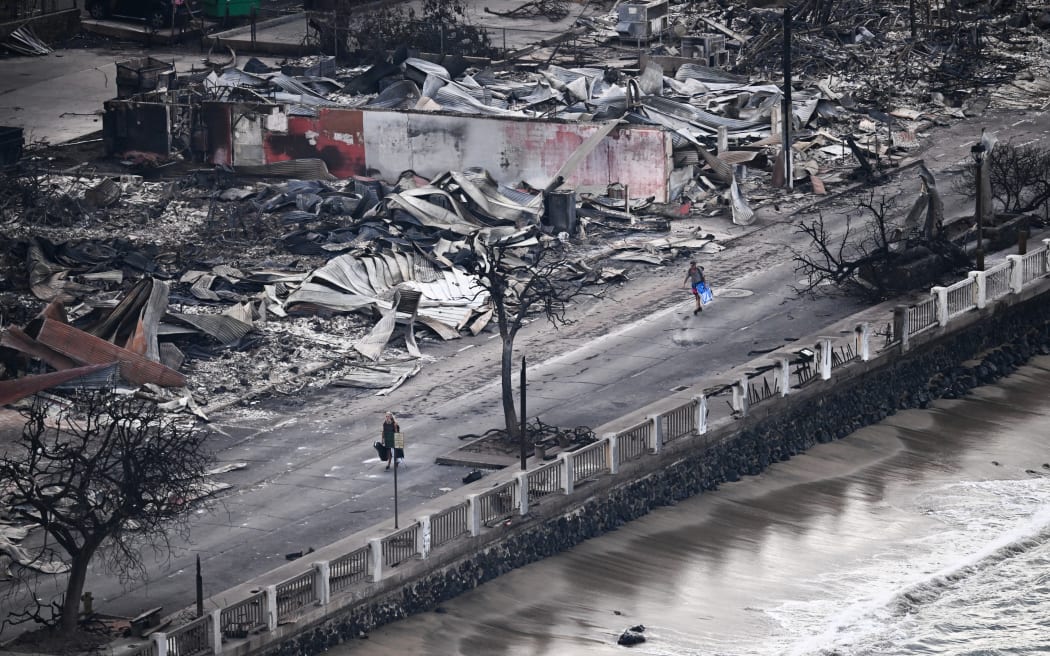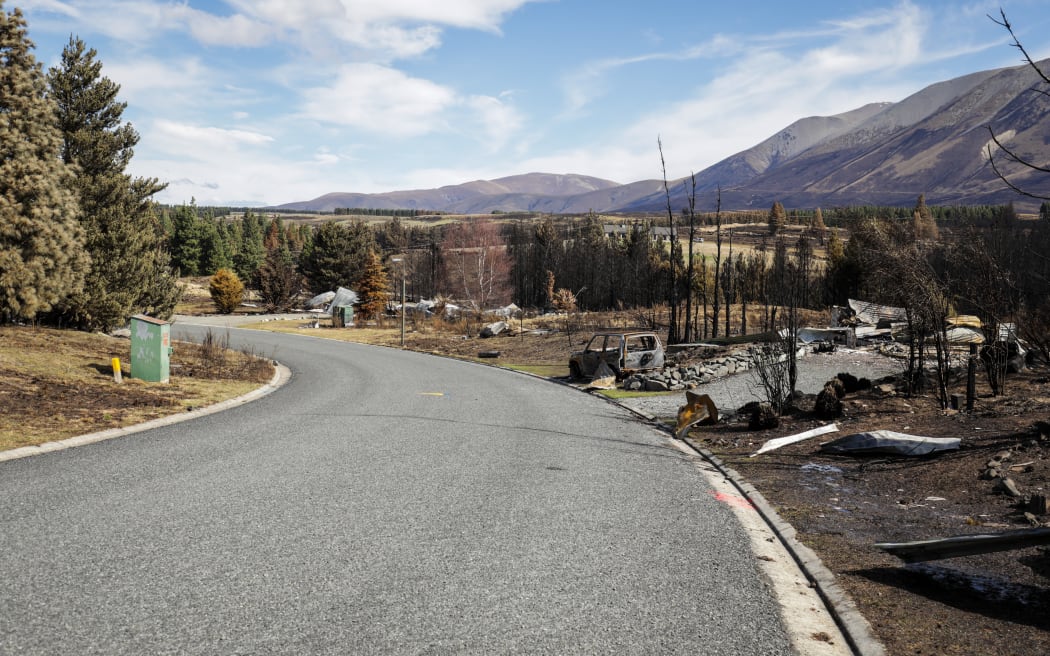New Zealand has watched from afar as wildfires have claimed lives and land across the heatwave-stricken northern hemisphere this year. As summer approaches, are we thinking enough about the threat wildfires pose here?

An aerial image taken on August 10, 2023 shows a person walking down Front Street past destroyed buildings burned to the ground in Lahaina in the aftermath of wildfires in western Maui, Hawaii. Photo: AFP / Patrick T. Fallon
New Zealanders are still recovering from Cyclone Gabrielle. Wringing out the mud and silt from their socks, putting windswept lives back together.
In the storm, orchards were swept away; roads were tumbled into rubble; lives were lost.
The dangers posed by wildfires are yet another in a long list of existential threats attached to living in this country.
"Everyone's going to have to start wrapping their mind around this new natural hazard," says University of Tasmania professor of pyrogeography and fire science David Bowman.
"You're very good at earthquakes and floods – fantastically adaptable people. It's just – damn! It's another thing you're going to have to start factoring in as the climate changes."
The Ministry for the Environment and Stats NZ reported in 2020 that New Zealand's fire danger is projected to increase by an average of 70 percent by 2040.
In the northern hemisphere, countless wildfires have started and spread viciously amid a summer of record temperatures – including in Greece, and most recently, in the Hawaiian town of Lahaina.
Bowman says both events were the result of "dysfunctional landscapes". In Greece, decades of urban drift saw swathes of once-cultivated countryside left abandoned and overgrown, allowing fire to spread relatively unimpeded.
"And in the Hawaiian situation, it's a completely different scenario. The traditional Hawaiians had cultivated things, were living on country, and that all got disrupted by plantations.
"All of these [foreign] grasses were introduced and they've just gone feral ... this happened across the Pacific. These grasses enter into what's known as a grass fire cycle. Grasses proliferate, they burn into woody vegetation, incinerate the woody vegetation, the woody vegetation is poorly adapted to fire, then you just get more and more grass. It feeds off the ash from the woody trees."
Bowman says the prospect of increasing wildfire incidence is going to be tough for New Zealanders to deal with.
"New Zealand has got a lot of grass, and a lot of plantations, eucalypts and pine. It's also got wild trees which have escaped into the grasslands. As you warm the climate ... those fuel types are going to become really challenging."
We have seen already how the natural environment can become a tinder box in the 2020 Lake Ohau wildfire.
Half of the small Mackenzie District community's houses were lost in the blaze.

The aftermath of the wildfire that ripped through the Lake Ohau township in October 2020. Photo: RNZ / Nate McKinnon
Three years on, Ohau resident and advocate Viv Smith-Campbell recalls how the burning wilding pines "turbo-charged" the fire, sending "fist-sized glowing embers" blowing into firefighters' faces.
Smith-Campbell tells The Detail how the community has been rebuilding the landscape with a focus on fire resilience – including people's gardens surrounding their houses,
She says Lincoln University has been running a "plant barbecue" to test the flammability of different types of greenery. Broadleaf, kowhai, five finger, and some of the coprosma species have been shown to be more fire resistant – the sorts of plants that might serve as a "green firebreak" in the event of an encroaching wildfire.
"The high-flammable ones, in contrast, are ake ake, mānuka and kānuka. They have lots of volatile oils in them and they'll burn really fiercely, and probably explode like the wilding pines do with resins," says Smith-Campbell.
Scion social scientist Simon Wegner, who researches wildfires, says while New Zealanders' awareness of the risks of wildfires has been rising, that doesn't necessarily correlate with preparedness.
Where people choose to live and how those dwellings are built and managed is a big part of wildfire mitigation.
"Very few councils have done anything in terms of putting specific policies in rules into their plans about wildfire. It's not usually listed as something to be considered in a consenting decision, it's not included in the LIM reports, typically," he says.
"All these decisions from the past are catching up with us, where we've built houses and developments where maybe they shouldn't have been built, and now we have to deal with that.
"In Australia and the United States, if you want to build a house in a high-risk area, then you need to meet higher standards for building: choose better materials, choose better designs... we don't have anything like that here."
Hear more about how individuals can mitigate their wildfire risk by listening to the full podcast.
Check out how to listen to and follow The Detail here.
You can also stay up-to-date by liking us on Facebook or following us on Twitter.

Photo:



